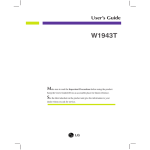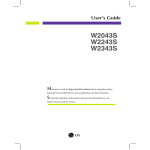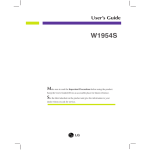Download LG W2600V User's Manual
Transcript
User’s Guide W2600V Make sure to read the Important Precautions before using the product. Keep the User's Guide(CD) in an accessible place for future reference. See the label attached on the product and give the information to your dealer when you ask for service. Important Precautions This unit has been engineered and manufactured to ensure your personal safety, however improper use may result in potential electrical shock or fire hazards. In order to allow the proper operation of all safeguards incorporated in this display, observe the following basic rules for its installation, use, and servicing. On Safety Use only the power cord supplied with the unit. In case you use another power cord, make sure that it is certified by the applicable national standards if not being provided by the supplier. If the power cable is faulty in any way, please contact the manufacturer or the nearest authorized repair service provider for a replacement. The power supply cord is used as the main disconnection device. Ensure that the socket-outlet is easily accessible after installation. Operate the display only from a power source indicated in the specifications of this manual or listed on the display. If you are not sure what type of power supply you have in your home, consult with your dealer. Overloaded AC outlets and extension cords are dangerous. So are frayed power cords and broken plugs. They may result in a shock or fire hazard. Call your service technician for replacement. Do not Open the Display: There are no user serviceable components inside. There are Dangerous High Voltages inside, even when the power is OFF. Contact your dealer if the display is not operating properly. To Avoid Personal Injury : Do not place the display on a sloping shelf unless properly secured. Use only a stand recommended by the manufacturer. Do not drop an object on or apply impact to the product. Do not throw any toys or objects on the product screen. It can cause injury to human, problem to product and damage the display. To Prevent Fire or Hazards: Always turn the display OFF if you leave the room for more than a short period of time. Never leave the display ON when leaving the house. Keep children from dropping or pushing objects into the display's cabinet openings. Some internal parts carry hazardous voltages. Do not add accessories that have not been designed for this display. When the display is to be left unattended for an extended period of time, unplug it from the wall outlet. In the presence of thunder and lightning, never touch the power cord and signal cable because it can be very dangerous. It can cause electric shock. On Installation Do not allow anything to rest upon or roll over the power cord, and do not place the display where the power cord is subject to damage. 1 Important Precautions Do not use this display near water such as near a bathtub, washbowl, kitchen sink, laundry tub, in a wet basement, or near a swimming pool. Displays are provided with ventilation openings in the cabinet to allow the release of heat generated during operation. If these openings are blocked, built-up heat can cause failures which may result in a fire hazard. Therefore, NEVER: Block the bottom ventilation slots by placing the display on a bed, sofa, rug, etc. Place the display in a built-in enclosure unless proper ventilation is provided. Cover the openings with cloth or other material. Place the display near or over a radiator or heat source. Do not rub or strike the Active Matrix LCD with anything hard as this may scratch, mar, or damage the Active Matrix LCD permanently. Do not press the LCD screen with your finger for a long time as this may cause some afterimages. Some dot defects may appear as Red, Green or Blue spots on the screen. However, this will have no impact or effect on the display performance. If possible, use the recommended resolution to obtain the best image quality for your LCD display. If used under any mode except the recommended resolution, some scaled or processed images may appear on the screen. However, this is characteristic of the fixed-resolution LCD panel. Leaving a fixed image on the screen for a long time may cause damage to the screen and cause image burn-in. Make sure to use a screen saver on the product. Burn-in and related problems are not covered by the warranty on this product. Do not shock or scratch the front and sides of the screen with metallic objects. Otherwise, it may cause damage to the screen. On Cleaning Unplug the display before cleaning the face of the display screen. Use a slightly damp (not wet) cloth. Do not use an aerosol directly on the display screen because over-spraying may cause electrical shock. On Repacking Do not throw away the carton and packing materials. They make an ideal container in which to transport the unit. When shipping the unit to another location, repack it in its original material. On Disposal The fluorescent lamp used in this product contains a small amount of mercury. Do not dispose of this product with general household waste. Disposal of this product must be carried out in accordance to the regulations of your local authority. 2 Connecting the Display Before setting up the monitor, ensure that the power to the monitor, the computer system, and other attached devices is turned off. Connecting the stand base or Removing the stand base 1. Place the monitor with its front facing downward on a cushion or soft cloth. 2. Align the hooks on the Stand Body with the matching slots in the Stand Base. 3. Insert the hooks into slots. Hook Stand Body Stand Base Slot Warning The tape and locking pin may only be removed from those monitors equipped with a standing base when the base is pulled up. Otherwise, you may be injured by the protruding sections of the stand. 3 Connecting the Display 4. Attach the monitor to the Stand Base by turning the screw to the right. Screw : Turn the screw by using the screw handle. 5. Lift and turn the monitor to face towards the front after the connection is made to the female part of the cable you're attaching. 6. Take the screw out by turning to the left to separate the monitor and Stand Base. Important This illustration depicts the general model of installation. Your monitor may differ from the items shown in the picture. Do not carry the product upside down holding only the stand base. The product may fall and get damaged or injure your foot. 4 Connecting the Display Before setting up the monitor, ensure that the power to the monitor, the computer system, and other attached devices is turned off. Positioning your display 1. Adjust the position of the panel in various ways for maximum comfort. Tilt Range : -5˚~20˚ Swivel Range : 350˚ Height Range : maximum 3.94 inches (100.0mm) 100.0mm * Please be sure to remove the Locking pin to adjust the height. Ergonomic You do not need to replace the Locking pin after it is removed, to adjust its height. It is recommended that in order to maintain an ergonomic and comfortable viewing position, the forward tilt angle of the monitor should not exceed 5 degrees. 5 Connecting the Display Using the Computer 1. Make sure to turn off the computer and product. Connect signal input cable 1 and power cord 2 in order, then tighten the screw of the signal cable. A Connect DVI(Digital signal) Cable B Connect D-sub(Analog signal) Cable (PC) C Connect D-sub(Analog signal) Cable (Mac) D Connect HDMI Cable NOTE This is a simplified representation of the rear view. This rear view represents a general model; your display may differ from the view as shown. User must use shielded signal interface cables (D-sub 15 pin cable, DVI cable) with ferrite cores to maintain standard compliance for the product. Power Cord 2 1 Signal Cable Varies according to model. Wall-outlet type PC MAC AV equipment (Set-Top Box, DVD, Video, Video Game Console) PC DVI-D(This feature is not available in all countries.) *HDMI is optimized on the AV equipment. Mac adapter For Apple Macintosh use, a separate plug adapter is needed to change the 15 pin high density (3 row) D-sub VGA connector on the supplied cable to a 15 pin 2 row connector. 6 Connecting the Display 2. Touch the power button on the front of panel to turn the power on. When monitor power is turned on, the 'Self Image Setting Function' is executed automatically. (Only to the D-sub signal cable input (RGB)) Power button NOTE 'Self Image Setting Function'? This function provides the user with optimal display settings.When the user connects the monitor for the first time, this function automatically adjusts the display to optimal settings for individual input signals. 'AUTO/SET Function'? When you encounter problems such as blurry screen, blurred letters, screen flicker or tilted screen while using the device or after changing screen resolution, touch the AUTO/SET function button to improve resolution. 3. Touch the SOURCE button at the front side of the monitor. When connecting with a D-sub signal cable. : Select RGB(D-sub analog signal). INPUT When connecting with a DVI signal input cable. : Select DVI(DVI digital signal). RGB DVI When connecting with a HDMI cable. : Select HDMI. HDMI 7 Connecting the Display Connecting the USB(Universal Serial Bus) Cable "USB (Universal Serial Bus)" is an innovation in connecting your different desktop peripherals conveniently to your computer. By using the USB, you will be able to connect your mouse, keyboard, and other peripherals to your display instead of having to connect them to your computer. This will give you greater flexibility in setting up your system. USB allows you to connect a chain of up to 120 devices on a single USB port; and you can “hot” plug (attach them while the computer is running) or unplug them while maintaining the Plug and the Plug auto detection and configuration. This display has an integrated BUSpowered USB hub, allowing up to 2 other USB devices to be attached it. 1. 2. Connect the upstream port of the display to the downstream port of the USB compliant PC or another hub using the USB cable. (Computer must have a USB port) Connect the USB compliant peripherals to the downstream ports of the display. USB downstream Port x (4) Connect the cables from USB compliant peripherals-such as mouse, memory stick or USB hard disk, etc. USB upstream Port x (1) Connect to downstream connectors of desktop or laptop computers. (However, the computer must support USB and have the USB port.) 3. The monitor’s USB terminal supports USB 2.0 and High Speed cables. Data Rate Power Consumption High Speed Full Speed Low Speed 480Mbps 12Mbps 1.5Mbps 2.5W (Max,each Port) 2.5W 2.5W (Max,each Port) (Max,each Port) NOTE To activate the USB hub function, the display must be connected to a USB compliant PC(OS) or another hub with the USB cable(enclosed). When connecting the USB cable, check that the shape of the connector at the cable side matches the shape at the connecting side. Even if the display is in a power saving mode, USB compliant devices will function when they are connected the USB ports(both the upstream and downstream) of the display. 8 Connecting the Display To arrange the cables Connect the power cord and the signal cable as shown in the figure and then fix them to the cable holders 1 and 2. 1. 2. Please insert the cable holder1 into the hole. Please put the power cord and the signal cable in the cable holder 1. Cable holder 1 3. Please put the power cord and the signal cable in the cable holder 2. While pressing the bottom of cable holder 2 with one hand, pull the top of it with the other hand as shown in the picture. Pull Press Cable holder 2 9 Control Panel Functions Front Panel Controls Button Button MENU Button Use this button to enter EZ ZOOMING, 4:3 IN WIDE, PHOTO EFFECT, SOUND items, for more information, refer to page 15 ~ 16. Use this button to enter On Screen Display Sub-menu to adjust BRIGHTNESS directly. Use this button to enter or exit from the On Screen Display. OSD LOCKED/UNLOCKED This function allows you to lock the current control settings, so that these settings are not inadvertently changed. To lock the OSD settings, press and hold the MENU button for several seconds. The message "OSD LOCKED" appears. You can unlock the OSD settings at any time by pushing the MENU button for several seconds. The message "OSD UNLOCKED" appears. 10 Control Panel Functions Buttons Use these buttons to select or adjust functions in the On Screen Display. For more information, refer to page 21~22. (SOURCE Hot key) AUTO/SET Button When 2 sets of computers are connected, you can select the input signal you want (RGB/DVI/HDMI). The default input signal is RGB. INPUT RGB DVI HDMI Use this button to enter a selection in the On Screen Display. AUTO IMAGE ADJUSTMENT When adjusting your display settings, always touch the AUTO/SET button before entering the On Screen Display(OSD). This will automatically adjust your display image to the ideal settings for the current screen resolution size (display mode). The best display mode is 1920 x 1200 Power Button (Power Indicator) Use this button to turn the display on or off. This Indicator lights up blue when the display operates normally(On Mode). If the display is in Sleep Mode (Energy Saving), this indicator color changes to amber. 11 On Screen Display (OSD) Control Adjustment Screen Adjustment Making adjustments to the image size, position and operating parameters of the display is quick and easy with the On Screen Display Control system. A short example is given below to familiarize you with the use of the controls. The following section is an outline of the available adjustments and selections you can make using the OSD. NOTE Allow the display to stabilize for at least 30 minutes before making image adjustments. To make adjustments in the On Screen Display, follow these steps: Touch the MENU Button, then the main menu of the OSD appears. To access a control, use the or Buttons. When the icon you want becomes highlighted, touch the AUTO/SET Button. Use the / Buttons to adjust the image to the desired level. Use the AUTO/SET Button to select other sub-menu items. Touch the MENU Button once to return to the main menu to select another function. Touch the MENU Button twice to exit from the OSD. 12 On Screen Display(OSD) Selection and Adjustment The following table indicates all the On Screen Display control, adjustment, and setting menus. Main menu Sub-menu R D H Reference EZ ZOOMING To adjust the resolution 4"3 IN WIDE To adjust the image size PHOTO EFFECT NORMAL GAUSSIAN BLUR To adjust screen color mode SEPIA MONOCHROME To select or turn off the sound SOUND PICTURE COLOR BRIGHTNESS CONTRAST GAMMA **BLACK LEVEL sRGB PRESET To adjust the brightness, contrast and gamma of the screen To set offset level 6500K 9300K To costomize the color of the screen RED GREEN BLUE TRACKING SETUP HORIZONTAL VERTICAL CLOCK PHASE SHARPNESS PIP To improve the clarity and stability of the screen LANGUAGE OSD POSITION FLATRON F-ENGINE To adjust the position of the screen HORIZONTAL VERTICAL To costomize the screen status for a user's operating environment WHITE BALANCE **OVERSCAN POWER INDICATOR FACTORY RESET MOVIE *INTERNET **GAME USER *NORMAL **STANDARD *DEMO **SPORTS To select or customize desired image settings PIP ON/OFF PIP POSITION To set PIP ● : Adjustable * : only for RGB/DVI Input ** : only for HDMI Input NOTE The order of icons may differ depending on the model (13~22). 13 R : RGB Input D : DVI Input H : HDMI Input On Screen Display(OSD) Selection and Adjustment You were introduced to the procedure of selecting and adjusting an item using the OSD system. Listed below are the icons, icon names, and icon descriptions of the all items shown on the Menu. Touch the MENU Button, then the main menu of the OSD appears. Main Menu MENU : Exit : Adjust (Decrease/Increase) SET : Enter : Select another sub-menu : Restart to select sub-menu Button Tip Menu Name Sub-menus Icons NOTE OSD (On Screen Display) menu languages on the monitor may differ from the manual. 14 On Screen Display(OSD) Selection and Adjustment The OSD screen will appear when you touch the bottom of the monitor. button on the left SOUND Main menu M E N U : Exit , : Move AUTO/SET : Select Description To select the adjust the resolution. When you select EZ ZOOMING in OSD, display resolution goes one step down so characters and images look bigger. When you select EZ ZOOMING once again, it goes back to the original resolution. EZ ZOOMING * To use this function, you must install forteManager program. For details, refer to the forteManager Installation Guide on the CD-ROM. * forteManager is not supported for HDMI input. To select the image size of the screen. 4:3 IN WIDE WIDE 4:3 1:1 • WIDE : Switch to full screen mode according to input image signal. • 4 : 3 : Change the image signal ratio into 4:3. • 1 : 1 : Change the image signal size into the input signal size. 15 On Screen Display(OSD) Selection and Adjustment Main menu Description To select the color of the screen. PHOTO EFFECT • NORMAL : The PhotoEffect function is disabled. • GAUSSIAN BLUR : This option is to add the effect to the screen that the dark and sharp image becomes brighter and more blurred. • SEPIA : This option changes the screen to be Sepia tone. The Sepia tone is brown color tone. • MONOCHROME : This option changed the screen to be Gray tone. The screen image is displayed with just white, black, gray colors. NORMAL SOUND GAUSSIAN BLUR SEPIA MONOCHROME To set the buzzer sound. Touch the AUTO/SET button from the OSD screen to select or mute the sound (2 types of buzzer sounds), and touch the MENU button to save. SOUND * The buzzer sound is generated only when you turn on/off the power, and MENU. 16 On Screen Display(OSD) Selection and Adjustment Main menu Sub menu Description PICTURE RGB/DVI input BRIGHTNESS To adjust the brightness of the screen. CONTRAST To adjust the contrast of the screen. GAMMA Set your own gamma value. : -50 / 0 / 50 On the monitor, high gamma values display whitish images and low gamma values display high contrast images. BLACK LEVEL You can set the offset level. If you select 'HIGH', the screen will be bright and if you select ‘LOW’, the screen will be dark. (only for HDMI input) HDMI input * Offset? As the criteria for video signal, it is the darkest screen the monitor can show. M E N U : Exit : Decrease : Increase AUTO/SET : Select another sub-menu COLOR PRESET • sRGB: Set the screen color to fit the sRGB standard color specification. • 6500K: Slightly reddish white. • 9300K: Slightly bluish white. RED Set your own red color levels. Set your own green color levels. GREEN M E N U : Exit : Decrease BLUE : Increase AUTO/SET : Select another sub-menu Set your own blue color levels. 17 On Screen Display(OSD) Selection and Adjustment Main menu Sub menu Description TRACKING HORIZONTAL To move image left and right. VERTICAL To move image up and down. CLOCK To minimize any vertical bars or stripes visible on the screen background. The horizontal screen size will also change. PHASE To adjust the focus of the display. This item allows you to remove any horizontal noise and clear or sharpen the image of characters. SHARPNESS To adjust the clearness of the screen. M E N U : Exit : Decrease : Increase AUTO/SET : Select another sub-menu 18 On Screen Display(OSD) Selection and Adjustment Main menu Sub menu Description LANGUAGE To choose the language in which the control names are displayed. OSD POSITION To adjust position of the OSD window on the screen. WHITE BALANCE If the output of the video card is different the required specifications, the color level may deteriorate due to video signal distortion. Using this function, the signal level is adjusted to fit into the standard output level of the video card in order to provide the optimal image. Activate this function when white and black colors are present in the screen. (only for RGB input) OVERSCAN To select the range of output image for DTV timing in HDMI input. (only for HDMI input) POWER INDICATOR Use this function to set the power indicator on the front side of the monitor to ON or OFF. If you set OFF, it will go off. If you set ON at any time, the power indicator will automatically be turned on. FACTORY RESET Restore all factory default settings except "LANGUAGE." Press the , buttons to reset immediately. SETUP RGB 1280 x 1024 60 Hz RGB input RGB 1280 x 1024 60 Hz HDMI input M E N U : Exit : Adjust : Adjust AUTO/SET : Select another sub-menu If this does not improve the screen image, restore the factory default settings. If necessary, perform the white balance function again. The white balance function is executed only for RGB input. 19 On Screen Display(OSD) Selection and Adjustment Main menu Sub menu Description PIP PIP ON/OFF PIP ON/OFF To select PIP on or off. * It supports only for HDMI input in RGB (D-sub analog signal) mode. * The combinations of main screen and sub-screen (PIP) available are as shown below: ON Main screen RGB DVI HDMI RGB X X X DVI X X X HDMI O X X Sub-screen (PIP) MENU : Exit : Adjust : Adjust AUTO/SET : Select another sub-menu PIP POSITION Select the PIP display location. Every time you touch the button, it will move from 1 to 2 , 3 , 4 . Every time you press the button, it will move from 1 to 4 , 3 , 2 . You can use this menu to select the PIP display location you want. 1 : Top left 2 : Bottom left 3 : Bottom right 4 : Top right *It operates only when PIP is on. 20 On Screen Display(OSD) Selection and Adjustment The OSD screen will appear when you touch the button on the left bottom of the monitor. These features let you easily select the best desired image condition optimized to the environment (ambient illumination, image types etc). Menu Name MENU : Exit , : Move SET : Select Icons Sub-menu Name Main menu Sub menu MOVIE Description Select this when you are watching a video or movie. RGB/DVI input INTERNET Select this when you are working on the document (Word etc.) HDMI input GAME Select this when you are playing a game. NORMAL Select this when you want to use the product in the most general using environment. RGB/DVI input HDMI input STANDARD Select this when you want to use the original standard video. * In the General (Standard) mode, the is turned off. 21 On Screen Display(OSD) Selection and Adjustment Main menu Sub menu Description RGB/DVI input DEMO This is used for advertising in the store. The screen will be divided to show the standard mode on the left and video mode on the right so that the consumers can check the difference after applying the video mode. HDMI input SPORTS Select this when you watching general sports. USER You can manually adjust brightness, ACE or RCM (only for RGB/DVI input), HUE or SATURATION (only for HDMI input). You can save or restore the adjusted value even when using a different environment. ... (Brightness) : Adjusts screen brightness. ... ACE(Adaptive Clarity Enhancer) : Selects the clarity mode. RGB/DVI input Not applied Weak clarity and luminosity contrast. Strong clarity and luminosity contrast. 50 1 ... RCM(Real Color Management) : Selects the color mode. 2 Not applied Green enhance Flesh tone Color Enhance HDMI input ... HUE : Adjust the screen hue. ... SATURATION : Adjust the screen saturation. 50 10 50 Select the sub-menu using the AUTO/SET button and save the YES value using the , buttons. MENU : Exit : Decrease : Increase AUTO/SET : Select another sub-menu 22 Troubleshooting Check the following before calling for service. No image appears ● Is the power cord of the • Check and see if the power cord is connected properly to the power outlet. display connected? ● Is the power indicator light on? • Touch the Power button. ● Is the power on and the • Adjust the brightness and the contrast. power indicator blue or green? ● Is the power indicator amber? • If the display is in power saving mode, try moving the mouse or pressing any key on the keyboard to bring up the screen. • Try to turn on the PC. ● Do you see an "OUT OF • This message appears when the signal from the PC (video card) is out of horizontal or vertical RANGE" message on frequency range of the display. See the the screen? 'Specifications' section of this manual and configure your display again. ● Do you see a "CHECK SIGNAL CABLE" message on the screen? • This message appears when the signal cable between your PC and your display is not connected. Check the signal cable and try again. Do you see a "OSD LOCKED" message on the screen? ● Do you see “OSD LOCKED” when you push MENU button? • You can secure the current control settings, so that they cannot be inadvertently changed. You can unlock the OSD controls at any time by pushing the MENU button for several seconds: the message “OSD UNLOCKED” will appear. 23 Troubleshooting Display image is incorrect ● Display Position is incorrect. • Touch the AUTO/SET button to automatically adjust your display image to the ideal setting. If the results are unsatisfactory, adjust the image position using the H position and V position icon in the on screen display. ● On the screen background, vertical bars or stripes are visible. • Touch the AUTO/SET button to automatically adjust your display image to the ideal setting. If the results are unsatisfactory, decrease the vertical bars or stripes using the CLOCK icon in the on screen display. ● Any horizontal noise appearing in any image or characters are not clearly portrayed. • Touch the AUTO/SET button to automatically adjust your display image to the ideal setting. If the results are unsatisfactory, decrease the horizontal bars using the PHASE icon in the on screen display. • Check Control Panel --> Display --> Settings and adjust the display to the recommended resolution or adjust the display image to the ideal setting. Set the color setting higher than 24 bits (true color). Important Check Control Panel --> Display --> Settings and see if the frequency or the resolution were changed. If yes, readjust the video card to the recommend resolution. Reasons for Recommending Optimal Resolution : The aspect ratio is 16:10. If the input resolution is not 16:10 (for instance, 16:9, 5:4, 4:3), you might encounter problems such as blurred letters, blurry screen, cut-off screen display or tilted screen. The setting method can differ by computer and O/S (Operation System), and resolution mentioned above may not be supported by the video card performance. In this case, please ask to the computer or the video card manufacturer. 24 Troubleshooting Display image is incorrect ● The screen color is mono or abnormal. • Check if the signal cable is properly connected and use a screwdriver to fasten if necessary. • Make sure the video card is properly inserted in the slot. • Set the color setting higher than 24 bits (true color) at Control Panel - Settings. ● The screen blinks. • Check if the screen is set to interlace mode and if yes, change it to the recommend resolution. Have you installed the display driver? ● Have you installed the display driver? • Be sure to install the display driver from the display driver CD (or diskette) that comes with your display. Or, you can also download the driver from our web site: http://www.lge.com. ● Do you see an "Unrecognized monitor, Plug&Play (VESA DDC) monitor found" message? • Make sure to check if the video card supports Plug&Play function. 25 Specifications Display 26 inches (64.868cm) Flat Panel Active matrix-TFT LCD Anti-Glare coating Visible diagonal size : 64.868 cm 0.2865 mm pixel pitch Sync Input Horizontal Freq. Vertical Freq. Input Form 30 - 83 kHz (Automatic) 56 - 75 Hz (Automatic) Separate Sync. SOG (Sync On Green) Digital(HDCP) Video Input Signal Input Input Form 15 pin D-Sub Connector DVI-D Connector (Digital), HDMI RGB Analog (0.7 Vp-p/ 75 ohm), Digital Resolution Max Recommend VESA 1920 x 1200 @60 Hz VESA 1920 x 1200 @60 Hz Plug&Play DDC 2B Power Consumption On Mode Sleep Mode Off Mode Dimensions &Weight Width Height Depth : ≤ ≤ 50W(Typ.), 65W(USB Full load) 1W 1W With Stand Without Stand 60.19 cm / 23.70 inches 60.19 cm / 23.70 inches 46.32 cm / 18.24 inches (Min) 41.37 cm / 16.29 inches 56.32 cm / 22.17 inches (Max) 27.02 cm / 10.64 inches 8.10 cm / 3.19 inches Weight(excl. packing) 10.6 kg (23.37 lbs) Range Tilt Swivel Height -5˚~20˚ 350˚ 100 mm / 3.94 inches Power Input AC 100-240V~ 50/60Hz 1.2A Environmental Conditions Operating Conditions Temperature 10˚C to 35 ˚C Humidity 10 % to 80 % non-Condensing Storage Conditions Temperature -20˚C to 60 ˚C Humidity 5 % to 90 % non-Condensing 26 Specifications Stand Base Attached ( Power cord Wall-outlet type or PC-outlet type USB Standard USB 2.0, Self-Power Data Rate Max 480 Mbps ), Detached ( O ) Power Consumption Max 2.5W x 4 NOTE Information in this document is subject to change without notice. 27 Specifications Preset Modes (Resolution) - D-sub(Analog) / DVI(Digital) INPUT Display Modes (Resolution) VGA VESA VESA VGA VESA VESA VESA VESA VESA VESA VESA VESA VESA VESA VESA VESA VESA 1 2 3 4 5 6 7 8 9 10 11 12 13 14 15 16 *17 Horizontal Freq. (kHz) 640 x 480 640 x 480 720 x 480 720 x 400 800 x 600 800 x 600 1024 x 768 1024 x 768 1152 x 864 1280 x 768 1280 x 768 1280 x 1024 1280 x 1024 1600 x 1200 1680 x 1050 1680 x 1050 1920 x 1200 31.469 37.500 35.162 31.500 37.879 46.875 48.363 60.023 67.500 47.776 60.289 63.981 79.976 75.000 64.674 65.290 74.038 Vertical Freq. (Hz) 59.940 75.000 59.901 70.156 60.317 75.000 60.004 75.029 75.000 59.870 74.893 60.020 75.025 60.000 59.883 60.454 59.950 *Recommend Mode HDMI Vedio INPUT Display Modes (Resolution) 1 2 3 4 5 6 7 8 Horizontal Freq. (kHz) Vertical Freq. (Hz) 31.50 31.25 37.50 45.00 28.12 33.75 56.25 67.50 60.00 50.00 50.00 60.00 50.00 60.00 50.00 60.00 480P 576P 720P 720P 1080i 1080i 1080P 1080P Indicator MODE On Mode Sleep Mode Off Mode LED Color Blue Amber Off 28 Installing the Wall mount plate This monitor satisfies the specifications of the Wall mount plate or the interchange device. 1. After moving the product to face downward, make sure to place it on a soft cloth or a cushion to avoid surface damage. 2. Separate the head and the stand with the use of a screwdriver. 3. Install the Wall mount plate. Wall mount plate(Separate purchase) This is stand-type or wall mount type and is connectable with Wall mount plate. Please refer to the installation guide for more details, which is provided when Wall mount plate is purchased. Kensington Security Slot Connected to a locking cable that can be purchased separately at most computer stores. 29 Digitally yours




















































